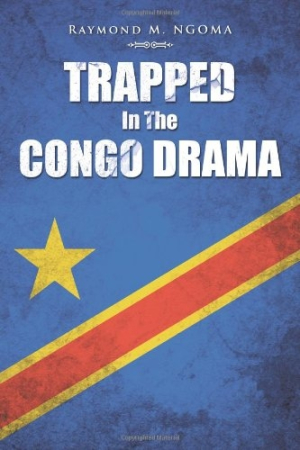It looks like you've stumbled upon a page meant to be read by our code instead of viewed directly. You're probably looking for this page.
Trapped in the Congo Drama
Based loosely on the author’s own life, Trapped in the Congo Drama is an ultimately unsatisfying story of two students who leave their African homeland to study in Prague in the mid-to-late 1980s. Most of the narrative fails to live up to its billing as a drama about the Congo.
The first sixty of the book’s 124 pages are about the experiences of a young man, Gilbert, while the following forty tell of a girl named Dorothy and how she and Gilbert meet studying abroad. There is very little drama and not much about the Congo, at least not until the last thirty pages when all hell breaks loose.
Author Raymond M. Ngoma writes in very short and simple sentences. His book has the feel and pace of a young adult novella, and most of it is quite light in theme and feel. The plot focuses on the travels and studies of innocents abroad, although Ngoma adds in a milder and far less tragic Congo version of Romeo and Juliet involving Dorothy and her childhood sweetheart, Thomas. There are some glimpses of life and society in Brazzaville and Kinshasha in the 1980s, but as most of the story is set in the student community in the capital of what was then Communist Czechoslovakia, the Congo gets short shrift until the thirteenth of the book’s sixteen chapters.
The final quarter of the novel is very different in pace and tone from the rest. Suddenly Ngoma shifts from a tale of two lovers to an exposé of corruption in the twin Congos (Republic and Democratic Republic). He then races breathlessly through a series of coups, civil wars, massacres, gang rapes, street battles, and other violent episodes which climax in a refugee exodus through a snake-infested forest. It all happens so fast that the reader can barely follow the action, let alone digest it, or even begin to comprehend the impact of these horrors on the principal characters.
The back cover focuses almost entirely on these final passages, giving the reader the impression that the book will be primarily about the tragedies that continue to haunt that troubled part of Africa. Ngoma, however, spends so much time dallying about in Europe that there is almost no buildup to the finale. When finally he does unleash his pen to describe the horrors that engulf the two Congos, it is too little and too late—and too rushed to have any real impact on the reader.
While these are understandably painful memories and themes for the author, they are nevertheless what the back cover promises the narrative is about. Most of what Ngoma has written in the thirteen chapters leading up to that payoff is pleasant enough but rather mundane, and it offers only a spare glance at the world into which his characters were born.
Ngoma’s prose has a secondary-school simplicity and sweetness to it, although he does have a habit of switching tenses in mid-sentence. There are a few passages, most of them about young girls who “captivate the hearts” of boys and their parents, that are guaranteed to bring a smile to the reader’s face. That said, most readers are likely to become impatient waiting for the story promised by the book’s packaging.
Reviewed by
Mark McLaughlin
Disclosure: This article is not an endorsement, but a review. The publisher of this book provided free copies of the book and paid a small fee to have their book reviewed by a professional reviewer. Foreword Reviews and Clarion Reviews make no guarantee that the publisher will receive a positive review. Foreword Magazine, Inc. is disclosing this in accordance with the Federal Trade Commission’s 16 CFR, Part 255.
